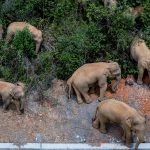A new recording featuring the sound of Mars has been released by China’s space agency.
The China National Space Administration (CNSA) released a series of audio files that were the first recorded by the country’s Mars rover Zhurong.
The sound was captured on 22 May by microphones installed on the rover, when it went for its first drive, about a week after it landed on the red planet.
Among the sounds that could be heard were the noises of the Mars rover’s engine and it rolling off the lander’s ramps.
Jia Yang, deputy chief designer of the Tianwen-1 Mars probe system, said: “The sounds were made when the pinion of the Mars rover rotates on the rack, or say the clashing sounds between metals.
“The purpose we install the recording device is to capture the sounds of wind on Mars during its windy weathers. We really want to hear how the winds sound like on a planet other than the Earth.”
The Chinese rover is the second to record sound from the Martian surface after NASA’s Perseverance Rover captured the sounds of wind on 20 February. NASA has since released a number of other recordings made by Perseverance.
The first ‘noise’ ever recorded on Mars, including marsquakes, was captured by NASA’s InSight lander after it arrived on the red planet in November 2019, but this was vibrations from the planet and surrounding area, rather than actual sound.
The Chinese recordings will further help the research by the country’s space scientists, while helping them plan for future Mars missions.
Liu Jizhong, deputy commander of China’s first Mars exploration program, said: “With the [video, image and audio] files we released this time, including those sounds recorded when our Mars rover left the lander, we are able to conduct in-depth analysis to the environment and condition of Mars, for example, the density of the atmosphere on the Mars.”
A series of new photos and videos captured by China’s Mars probe Tianwen-1 during the rover’s landing and Zhurong’s early exploration have also been released.
The images include the opening of the parachute and the descent of the rover, the environment it found itself in after it landed, and the ruts of the rover as it moved around.
China is only the second country after the United States to land and operate a moving rover on Mars.
The six-wheeled solar-powered Zhurong rover, which resembles a blue butterfly and weighs 240 kg on earth, is named after the god of fire in ancient Chinese mythology.
So far, it has been active for 42 Martian days (about 43 Earth days) and has moved 236 metres.
It is expected to go on recording the Martian landscape with high-resolution three-dimensional images, analyse the material composition of the planet’s surface, detect its sub-surface structure and magnetic field, search for traces of water ice and observe the surrounding meteorological environment.






















